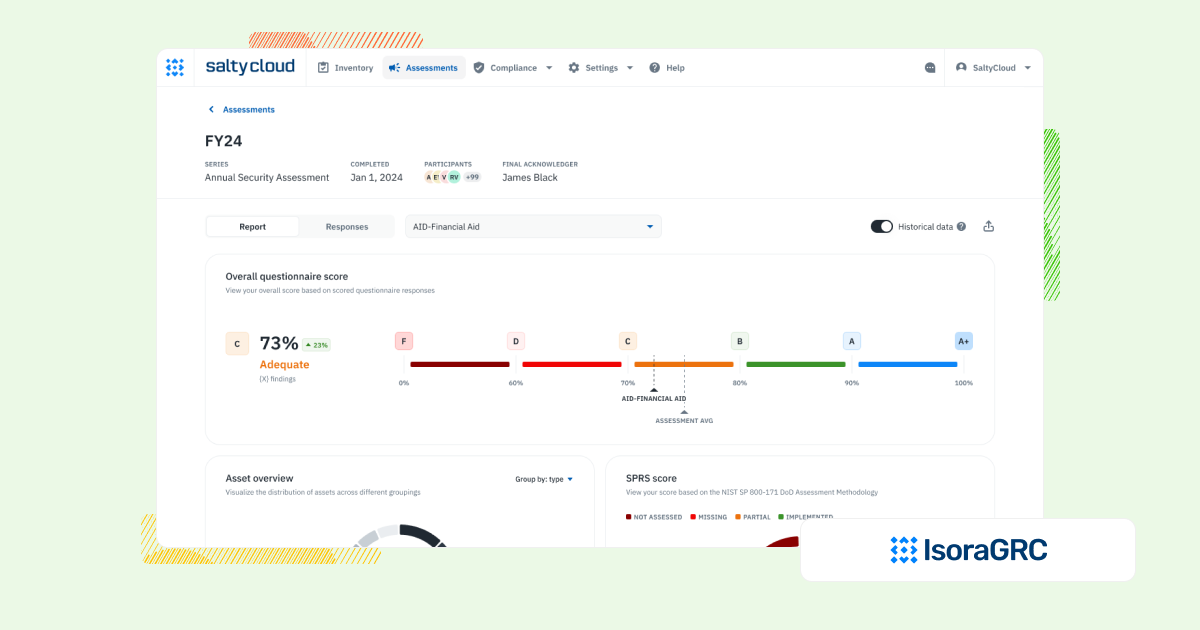
Every security team needs a scalable, efficient way to manage IT risk—not just settle for a tool that lacks depth or tries to do too much.
Platforms like Eramba and Archer IRM offer varying solutions, with Eramba providing a lightweight, budget-friendly option and Archer IRM offering broad functionality.
But lightweight tools may look simple, but they lack the structure and scalability teams need to grow a real risk program. And when a platform tries to do everything, security teams are often left with too much complexity and not enough clarity.
Isora GRC takes a different approach. It’s purpose-built for security teams who need to run assessments, manage inventories, and track risks—offering a focused, scalable solution that keeps things simple without sacrificing depth.
Let’s take a closer look.
Choosing the Right Platform for IT Risk Management
Eramba is a free, open-source tool that offers core GRC functionality—but often requires technical configuration and ongoing maintenance. Archer IRM is a highly configurable, enterprise-grade platform—but one that demands extensive setup, customization, and administrative overhead. Both tools represent extremes: one is limited in scope, the other is overbuilt.
Isora GRC offers a modern alternative that balances power and usability. It gives teams structured workflows for assessments, inventories, exceptions, and risk tracking—without the drag of long implementations or unsupported complexity. It’s a platform designed specifically for information security teams, not retrofitted for them.
The Workflow That Matters: Managing IT Risks and Compliance
Security teams need to issue assessments, review responses, manage inventories, log exceptions, and generate reports—without getting stuck in outdated interfaces or one-size-fits-all workflows.
Isora GRC delivers clean, repeatable processes that drive participation and keep risk visible across departments and vendors. Whether you’re moving up from a free tool or moving away from a bloated enterprise suite, Isora provides a reliable, flexible foundation for scaling your IT risk program.
How Each Platform Supports IT Risk Management Workflows
| Workflow Area | Eramba | Archer IRM | Isora GRC |
| Assessment Management | Eramba gives basic tools for assessments. Many users say the system feels shallow and hard to adjust. Custom options stay limited, and setting up automation takes time. This often leads to more manual work and slower progress. | Document-driven approach with complex approval workflows. Requires specialized resources and extensive professional services to implement properly. | Centralized, intuitive assessment dashboard across business units, vendors, and assets. Built specifically for security teams. |
| Questionnaire Delivery & Completion | The survey tool in Eramba feels too simple. It lacks strong options for detailed forms. Users find the layout confusing and hard to use. Building and managing surveys becomes a slow task. Connecting with other tools for smooth data flow also needs improvement. | Limited questionnaire capabilities that require extensive configuration. Not designed for end-user completion, requiring technical mediators. | Customizable and prebuilt questionnaires for frameworks like NIST, ISO, GLBA, HIPAA, and more. Designed for internal and external collaboration. |
| Inventory Tracking | Tracking assets with Eramba feels limited. It misses helpful features needed by bigger teams. Managing many assets gets harder with no strong links to outside systems. This weakens support for teams with mixed tools and large inventories. | Extensive asset and entity management requiring specialized setup and ongoing maintenance. Complex hierarchies that are difficult to navigate and maintain. | Centralized tracking of assets, vendors, and organizational units with integration support for existing data sources. |
| Risk Register & Exception Management | Eramba’s risk register stays basic with little room to adjust. Handling exceptions also needs a lot of manual setup. The system can’t handle complex flows, which hurts teams with detailed risk needs. | Advanced risk register requiring specialized knowledge with formal signoff processes that create bottlenecks. Exception governance managed through multiple modules requiring integration. | Flexible, collaborative risk register with scoring, status, evidence, and ownership tied directly to assessments. Exception management is built-in and intuitive—no extra modules or configuration required. |
| Scoring, Reporting & Risk Visualization | Scoring and reporting tools work but lack power. Many users say reports feel limited and hard to use. Visual risk data stays weak, and creating useful reports often needs tech help. | Powerful but complex reporting capabilities requiring significant consultant hours to set up. Difficult to modify without specialized knowledge. | Automated scorecards, risk maps, and executive-friendly reports with actionable insights—no manual config required. |
| Collaboration & User Experience | The layout feels old and confusing. Teamwork tools don’t work well together. Sharing info takes effort, and group work feels clunky. A cleaner, simpler design could help teams move faster. | Steep learning curve with overwhelming interface. Collaboration through “Archer Engage” but lacks intuitive discussion tools. Most users need extensive training. | WCAG-compliant, award-nominated interface with built-in commenting, team workflows, and fast onboarding. |
| Implementation & Setup | Setting up Eramba takes time. Users often need to adjust many things before use. While the price feels low, the setup feels long and harder to manage. | Implementation typically takes months to years with specialized resources. High total cost of ownership with significant consulting and internal resource requirements. | No-code setup in days or weeks. Minimal IT lift required. Designed to go live quickly across teams and vendors. |
What Sets Isora GRC Apart?

Isora GRC was purpose-built for information security teams—designed to support the real workflows behind risk and compliance, not just generate reports. While legacy GRC platforms require months of configuration and rigid processes, Isora takes a modern, scalable approach:
- Purpose-built for security and third-party risk teams
- No extra modules or cross-department bloat—just the workflows that matter.
- Easy for anyone to use
- Clean UI, no complex training, and built to drive adoption across the org.
- Streamlined for action, not just documentation
- Assessments, questionnaires, inventories, risk tracking, and reporting—all in one place.
- Fast, no-code implementation
- Go live in weeks, not quarters, with minimal IT lift.
- Scales with your program
- Whether you’re running a lean risk function or supporting a large institution, Isora grows with you—without getting in the way.
Who Each Platform Is Best For
| Platform | Who It’s For |
| Eramba | Security folks who like open-source tools and don’t mind doing setup themselves. Not great for busy teams. |
| Archer IRM | Large businesses, especially in finance or government, that need custom tools to track risk and follow strict rules. |
| Isora GRC | Security teams that need a scalable, usable IT risk management program across their organization. |
What Our Customers Say About Isora GRC
Security teams at top institutions are using Isora GRC to replace legacy tools and manual processes with intuitive workflows and actionable insight.
“Moving from manual processes to using Isora was a breath of fresh air. What used to take months is now automated, reliable, and defensible. Isora saves us significant time while delivering accurate insights that improve decision-making.”
Jessica Sandy, IT GRC Manager, The University of Chicago
“Isora has been essential in helping us meet our University of California cybersecurity requirements across a decentralized campus. Automating assessment data collection and reporting has given us clear visibility into unit-level risks, enabling us to prioritize resources effectively and address gaps with confidence.”
Allison Henry, CISO, The University of California, Berkeley
FAQs
What’s the difference between Eramba, Archer IRM, and Isora GRC?
Archer IRM is a complex, enterprise GRC platform built to serve multiple departments across large organizations. Eramba is an open-source GRC tool with basic functionality, best suited for small teams. Isora GRC strikes a balance—offering a modern, streamlined platform focused on IT and third-party risk workflows, purpose-built for security teams.
Are Eramba and Archer IRM considered GRC platforms?
Yes, but with different levels of complexity. Archer IRM supports a wide range of use cases but requires heavy configuration and long implementation timelines. Eramba offers essential GRC functions but lacks the scalability and usability needed by larger organizations. Isora GRC provides structured workflows without the overhead—ideal for teams that need to move quickly.
Does Isora GRC replace tools like Eramba or Archer IRM?
Yes. Isora GRC is a flexible platform that supports internal and vendor risk assessments, exception management, and inventory tracking—all in a user-friendly interface that’s quick to implement and easy to scale.
Which platform is better for managing IT and vendor risk workflows?
Isora GRC is purpose-built for security teams managing these workflows daily. It enables assessments, real-time tracking, collaboration, and broad adoption without the burden of complexity or the limitations of open-source tools.
Can Isora GRC be used alongside Eramba or Archer IRM?
It can, but most organizations choose Isora as a full replacement—either graduating from open-source tools like Eramba or moving away from bulky enterprise platforms like Archer to improve usability and adoption.
What should I look for in a GRC platform that balances power and usability?
Look for structured assessments, inventory and exception tracking, fast deployment, and cross-functional adoption. Isora GRC delivers these capabilities in a platform designed for real-world security and risk workflows.



















 Other Relevant Content
Other Relevant Content